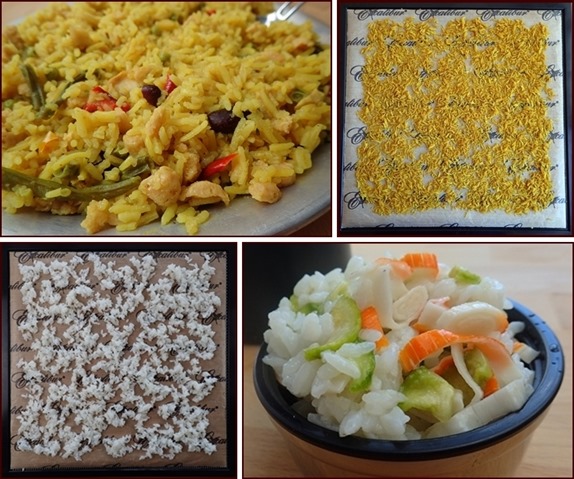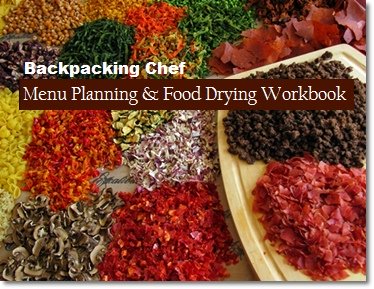Dehydrating Rice & Risotto
This page covers pre-cooking and dehydrating rice. The first method uses vegetable, chicken, or beef broth in place of water, followed by recipes for dehydrating risotto, curry-seasoned basmati rice, and sushi rice.
Instant rice adds very little nutrition or flavor to backpacking meals, and regular long grain rice takes too long to cook on the trail.
Pre-cooking and dehydrating rice is a great way to make flavorful and fast-cooking rice for trail meals. Learn how to dehydrate rice, and you'll never go back to instant rice again.
Table of Contents
Dehydrating Rice: Safety Update (June 2023)
Best Practices for Dehydrating Rice Safely
Dehydrating Rice Pre-cooked in Broth

Photo: Cooked long grain rice before and after drying.
Dehydrating Rice: Safety Update (June 2023)
The new recommended temperature for dehydrating rice is 145°F (63°C).
Although I have dehydrated rice at 125°F (52°C) for many years without incident, new information has come to light which has convinced me that drying rice at 145°F (63°C) is safer.
Uncooked rice may contain spores from a spore-forming bacterium called Bacillus cereus. These bacteria are common in soil, and the spores are often found in rice. The spores are resistant to cooking and dehydration, meaning they could germinate into bacteria after the rice is cooked and still wet.
Bacillus cereus forms toxins as it grows, which may cause food poisoning. Some of these toxins are heat stable, so once toxins are present, you cannot make the rice safe by cooking it again.
The incidence of Bacillus cereus food poisoning from cooked rice occurs commonly in restaurants that hold cooked rice below 135°F (57°C) for too long before serving it. It also occurs in homes where cooked rice is left out at room temperature—like rice salad sitting out at a picnic all day. Another possible cause is when leftover rice is left in the refrigerator for more than 4 days.
The US FDA recommends that food service operations keep hot foods, such as cooked rice, above 135°F (57°C) during the holding period between cooking and serving.
According to the FDA, “the temperature range between 135°F (57°C) and 41°F (5°C) is known as the danger zone for food storage and should be avoided.”
Backpacking Chef now recommends dehydrating rice above the danger zone. Rice dehydrates perfectly well, and faster, at 145°F (63°C). It rehydrates in meals on the trail just fine.
References:
Preventing Foodborne Illness: Bacillus cereus. University of Florida, available from: https://www.nifa.usda.gov/sites/default/files/resource/Preventing-Foodborne-Illness-Bacillus-cereus.pdf
Risk of Bacillus cereus in Relation to Rice, available from: https://www.ncbi.nlm.nih.gov/pmc/articles/PMC7913059/
This safety update was reviewed by Dr. Don Schaffner, Ph.D., Distinguished Professor and Extension Specialist in Food Science, Rutgers University.
Best Practices for Dehydrating Rice Safely
Transfer cooked rice directly to the dehydrator. Don’t leave it out at room temperature for more than a few minutes.
If you have more cooked rice than will fit in the dehydrator, cool it immediately and store it in the refrigerator. Avoid dehydrating rice that has been in the refrigerator for more than a day.
Temperature: 145°F (63°C).
Time: 4–6 hours. Rice may be dry in as little as 4 hours in an efficient dehydrator. After 2 hours, pull any rice nests that are sticking together apart, and redistribute the rice on the dehydrator trays. Dried rice will be hard and snappy.
Store dehydrated rice in an air and moisture-proof container.
For cold-soak rehydration of rice salads, limit the rehydration time to 2 hours. A thermos food jar is ideal for keeping rice meals from warming up as you hike. One hour is usually sufficient for rehydrating rice with cold water.
A thermos food jar will hold the heat in the safe zone when rice meals are rehydrated with boiled water and consumed 3–4 hours later.
Dehydrating Rice Pre-cooked in Broth
Cook
rice following the directions on the bag, but use beef, chicken, or
vegetable broth instead of plain water. The usual method is to bring 2
to 2½ cups of liquid to a boil, stir in 1 cup rice, cover and reduce
heat to low. Simmer until all liquid is absorbed and rice is tender.
Time varies with rice selection.
Use low or no-fat broths that come in a carton since fatty broths may cause the rice to spoil later.
In a pinch, use bouillon cubes to make the broth. Additional flavors can be added before dehydrating rice, such as a teaspoon of soy sauce per cup of cooked rice for an Asian flavor. A pinch of saffron adds a nice yellow color and unique taste to rice.
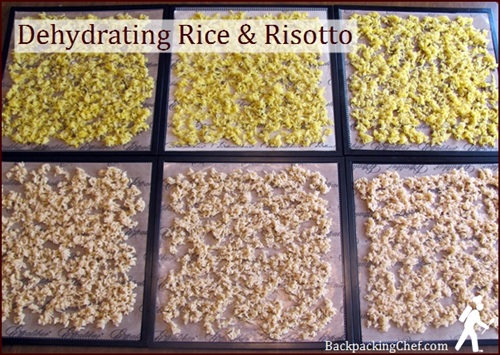
How to Dehydrate Rice
Spread cooked rice out on dehydrator trays covered with non-stick sheets, parchment paper or the liners that came with your unit. Dry the rice at 145°F (63°C) for approximately 4–6 hours. Dehydrating rice times vary with dehydrator models and humidity. Once or twice through the drying process, break up any rice that is stuck together. It’s not a problem if some rice remains stuck together since it will separate when you cook it on the trail. Rice will be hard when properly dried.
Yields: One cup uncooked rice = 3½ cups cooked = approximately 1¾ to 2 cups dried.
I use an Excalibur dehydrator for dehydrating rice. It is easy to transfer the dried rice from the non-stick sheets directly into storage containers. That simple task is not as easy with other dehydrators that have donut shaped trays.
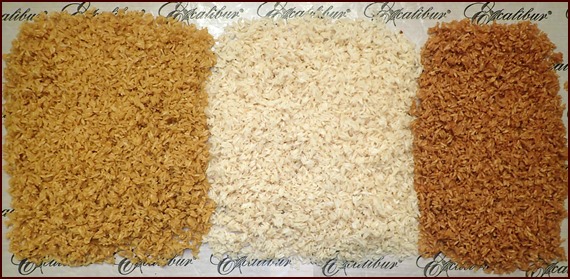
Photo (left to right): Dehydrating rice pre-cooked in vegetable, chicken, and beef broth. Notice the change in color in the dried rice, which makes backpacking meals more interesting.
Include ground beef in meals with beef-flavored rice, and chicken with chicken-flavored rice. Ham, seafood, and vegetable proteins go well with vegetable-flavored rice. Rehydrated dried rice is slightly chewier, in a pleasant way, than instant rice.
The photo below shows chicken-flavored rice with ham and mixed vegetables.
Meat & Vegetables with Rice
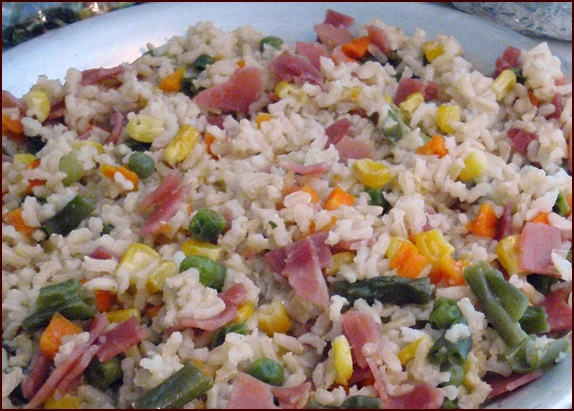
Servings: 1
Ingredients:
- ½ cup dried rice (pre-cooked in vegetable, chicken, or beef broth)
- ¼ cup dried meat (ham, chicken, ground beef, or shrimp)*
- ¼ cup dried mixed vegetables, any kind
- salt and pepper to taste
- 1 cup water to rehydrate
* Dried beans, lentils, or TVP may be substituted for dried meat.
On the Trail:
Combine all ingredients with water in pot and soak for 5 minutes. Light stove and bring to a boil for one minute. Transfer pot to insulating cozy for 15 minutes.
How to Make and Dehydrate Risotto
Make risotto with short-grain rice. Short-grain rice releases more starch than long grain rice which enhances the creamy texture of risotto.
Saffron adds a nice touch to this risotto recipe, but you can make risotto without it. Likewise, you may omit the mushrooms and white wine. If you don’t use white wine, use more broth or water.

Photo: Cooked risotto before and after drying.
Ingredients:
- 1 cup short-grain rice
- ½ medium red onion, diced
- 1 cup mushrooms, sliced
- 1 clove garlic, minced
- 1 pinch saffron
- 2 cups chicken or vegetable broth
- ½ cup white wine
- 1 Tbsp. olive oil
- 3 Tbsp. parmesan cheese
Servings: 2 - 3
At Home:
Bring chicken or vegetable broth to a boil in a pot and then turn off the heat. You may use a bouillon cube to make the broth.
In another pot, cook onions and garlic in olive oil over medium heat for a few minutes until onions are translucent.
Add rice and stir continuously for another minute.
Add ½ cup white wine or broth and stir continuously until liquid is absorbed.
Add mushrooms and then add more broth a ½ cup at a time, stirring frequently. Allow the rice to absorb most of the broth before you add the next ½ cup broth.
After 15 to 20 minutes of cooking, the risotto will be nice and creamy. Normally, you would stir in parmesan cheese and serve immediately. Since you will be drying the risotto, let it cool a bit. Pack the parmesan cheese separately and add it on the trail.
Dry the same way as long grain rice. Risotto will stick together more than long grain rice. Wait until it has been in the dehydrator for three hours and then pull it apart as best you can. After about four hours you can rub the risotto against itself in your hands to break it up even more. Then spread it out again for the final hour or so of drying.
Pack parmesan cheese in a small plastic bag and enclose with individual servings of risotto.
One Regular Serving:
- 1 cup dried risotto
- 2 Tbsp. parmesan cheese
- 1 cup water to rehydrate
To enjoy risotto as a side dish, reduce portions by half.
For a larger backpacking meal, add dried chicken, legumes, and vegetables. Increase water for rehydration by an equal quantitiy.
On the Trail:
Combine
dried risotto with water in pot and soak for five minutes. Light stove,
bring to boil and cook for one more minute. Remove from stove, stir in
parmesan cheese, and wait ten minutes. Insulate pot.
Dehydrating Basmati Rice with Curry Seasonings
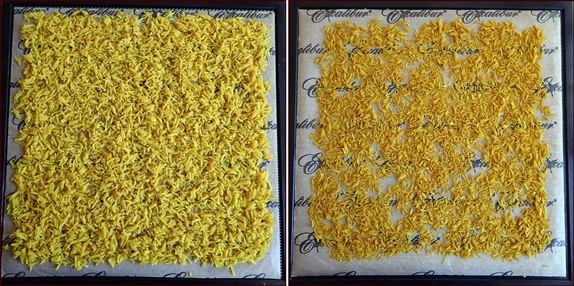
Basmati rice is a long and slender-grained aromatic rice traditionally used in Indian cooking with curry seasonings. The following recipe adds the curry seasonings to the rice as it cooks.
Makes 8 cups before drying, 3⅓ cups after drying.
Ingredients:
- 2 cups basmati rice (350 g)
- 2 Tbsp. curry powder
- 1½ tsp. salt
- 1½ tsp. cayenne pepper
- 1 tsp. cumin
- 1 tsp. coriander
- 1 tsp. paprika
- ½ tsp. vegetable bouillon
- 3½ cups water
Curry powder is a blend of several Indian spices which is sold in mild or sharp varieties. Some of the spices in this basmati rice recipe are included in curry powder, but adding the extra individual spices gives the rice more flavor and aroma to carry a complete backpacking meal. If you lack any of the extra spices, simply increase the curry powder by that amount.
Cooking Basmati Rice
Combine all ingredients with water in pot. Bring to a boil, then reduce to low simmer for 12 minutes, keeping the lid on the pot.
Remove pot from heat and let stand with the lid on for 10 minutes.
Dehydrating Basmati Rice
Spread cooked rice on dehydrator trays covered with nonstick sheets. This recipe yields 8 cups of cooked rice, which can be dehydrated on 3 Excalibur dehydrator trays.
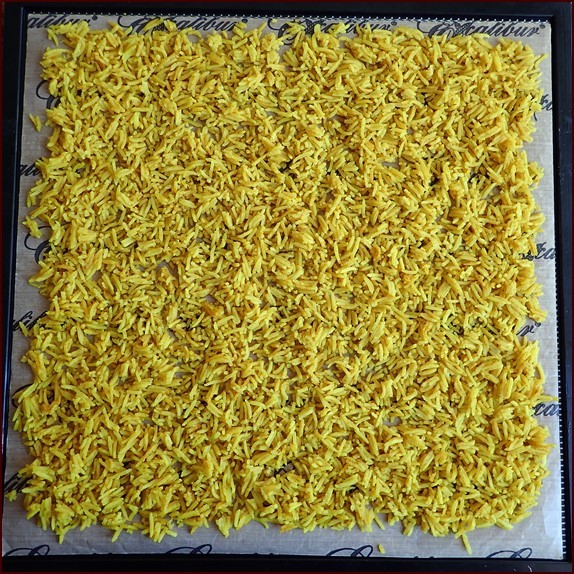
Dehydrate rice at 145°F (63°C) for approximately 4–6 hours. Dried rice will be crispy.
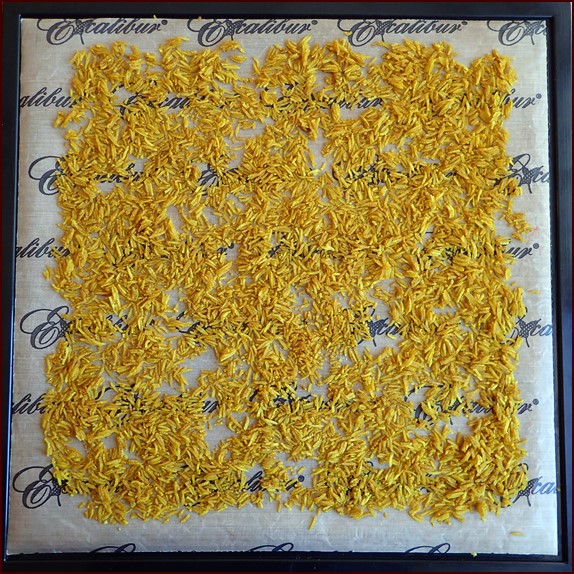
Store dehydrated basmati rice in a container with a tight-fitting lid until ready to combine with other ingredients to make backpacking meals like the two featured below.
Curry Basmati Rice & Vegetables
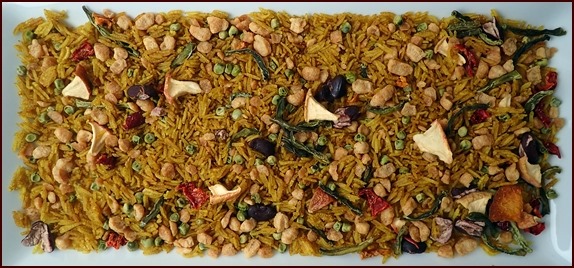
Photo: Dried ingredients for Curry Basmati Rice & Vegetables.
Servings: 1 large
Ingredients:
- ¾ cup dried curry-seasoned basmati rice
- ⅓ cup dried mixed vegetables*
- ⅓ cup dried chicken, beans, or TVP**
- 2 cups water to rehydrate
* Include a pinch of dried apples, mango, or apricots with the vegetables.
** Any protein source can be used in the recipe, such as dried chicken or shrimp, dried beans or lentils, or textured vegetable protein (TVP). Photo shows chicken-flavored TVP as the protein source.
On the Trail:
Combine all ingredients with water in pot and soak for 5 minutes. Light stove and bring to a boil for one minute. Transfer pot to insulating cozy for 15 minutes.
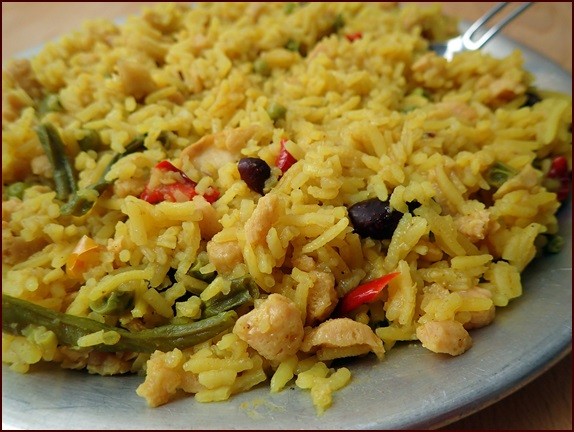
Photo: Rehydrated Curry Basmati Rice & Vegetables.
Coconut Shrimp Curry with Mango
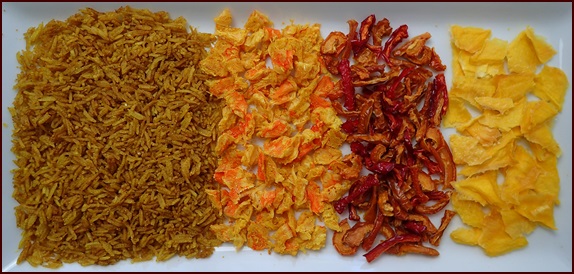
Dehydrated basmati rice, shrimp, bell pepper, and mango.
Servings: 1
Ingredients:
- ½ cup dried curry-seasoned basmati rice (60 g)
- ¼ cup dried shrimp, seasoned with curry powder before drying (20 g)
- ¼ cup dried bell peppers (15 g)
- ¼ cup dried mango
- 3 Tbsp. coconut milk powder
- ½ tsp. curry powder
- ¼ tsp. paprika
- ⅛ tsp. salt
- 2 cups water to rehydrate
At Home:
Pack coconut milk powder separately.
On the Trail:
Combine all ingredients with water in pot and soak for 5 minutes. Light stove and bring to a boil for one minute. Transfer pot to insulating cozy for 15 minutes.
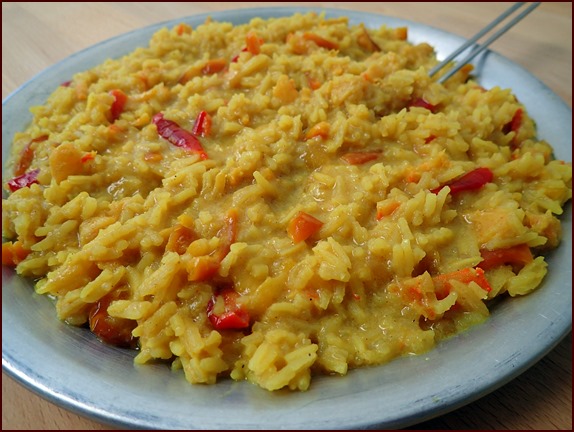
Rehydrated Coconut Shrimp Curry with Mango. The coconut milk powder creates a creamy sauce.
Cooking & Dehydrating Jasmine Rice
Jasmine rice is a long-grain rice, though not as long as basmati rice. It is favored in Thai dishes for its flowery and nutty taste and aroma. Cooking instructions often call for rinsing the starch off the rice before cooking it, but I skip the rinse because the starch improves the creamy texture of Thai curry backpacking meals.
Less liquid is used to cook jasmine rice than other long-grain rice. Use low-fat chicken, beef, or vegetable broth as the liquid, or use plain water. If using plain water, add ¼ teaspoon of salt to the water per cup of rice.
Cooking
Jasmine Rice
Ingredients:
- 1 cup jasmine rice (175 g)
- 1¼ cup low-fat chicken, beef, or vegetable broth
- ¼ tsp. salt if using plain water
Combine rice and water in pot and bring to a rapid boil. Reduce heat to lowest setting. Give the rice a minute with the lid off the pot after you turn down the heat so the rice doesn’t boil over. Then put the lid on the pot and simmer rice for 12 minutes.
Without lifting the lid, remove cooked rice from heat and let stand 10 more minutes.
Fluff with a fork.
Yields: 1 cup jasmine rice = 3 cups cooked = 1½ cups dried (162 g dried)
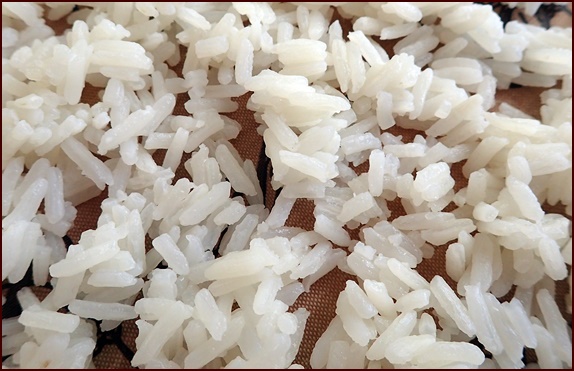
Photo: Cooked jasmine rice on dehydrator tray covered with nonstick sheet.
Dehydrating Jasmine Rice
Spread cooked rice on dehydrator tray covered with nonstick sheet. Make small piles and pull them apart with a fork. Don’t worry if the rice sticks to itself—you can pull any small clumps of rice apart after the rice is substantially dry.
Dehydrate jasmine rice at 145°F (63°C) for approximately 4–6 hours. Dried rice will be crispy.
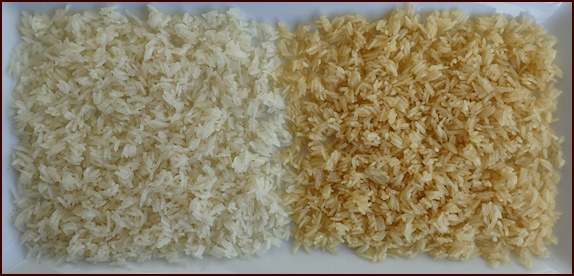
Photo: Dehydrated jasmine rice precooked in water with salt (left) or low-fat chicken broth (right).
Jasmine rice is featured in my Thai Green Curry and Thai Red Curry backpacking meals.
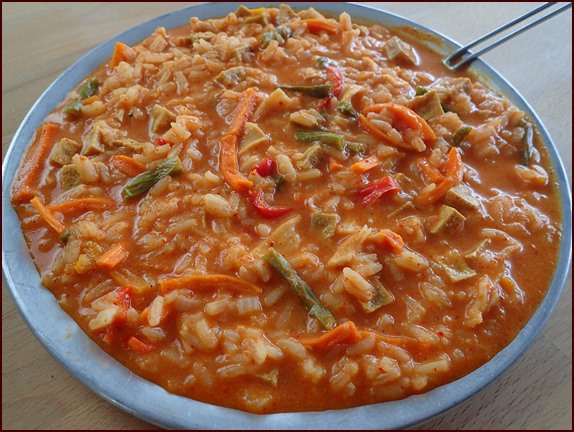
Dehydrating Sushi Rice
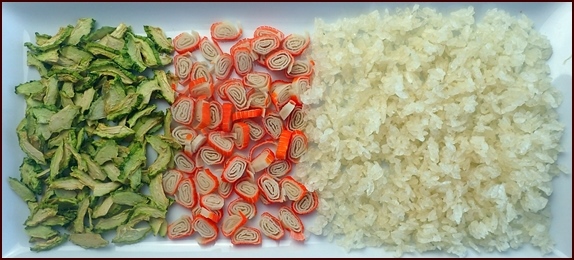
Photo shows dried ingredients used to make a cold-soak sushi rice bowl salad: dehydrated cucumber, surimi, and sushi rice.
Sushi rice is a short-grain rice which is cooked with less water than is used to cook long-grain rice. If available, choose Japanese sushi rice.
Rice vinegar is added to the rice after it is cooked.
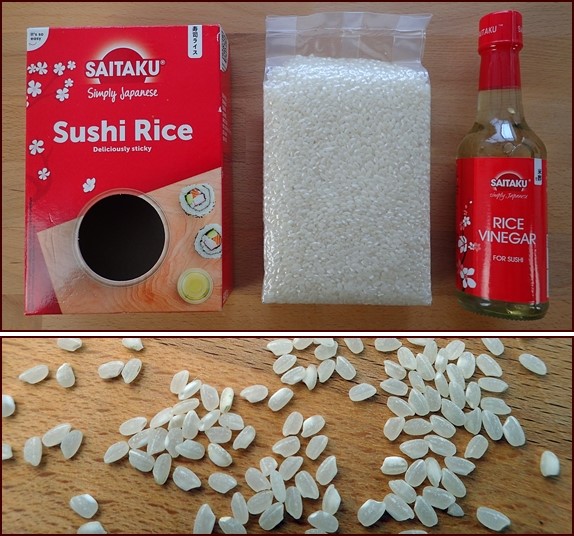
The ingredients needed to make sushi rice, besides the short-grain rice, are rice vinegar, sugar, and salt. Check the ingredients list of the rice vinegar you buy; it may already include sugar or salt. The rice vinegar used for this recipe included sugar, but no salt.
Cooking Sushi Rice
If the rice vinegar does not contain salt or sugar, add those items to the rice vinegar in a separate pot. Heat on low temperature until the salt and/or sugar dissolve. You can do this while the rice is cooking. Overheating the rice vinegar will cause a loss of flavor. That is why you do not add it to the rice until after the rice is cooked.
To cook 1¼ cups (250 g) of sushi rice, use 5 tablespoons of rice vinegar, 2½ teaspoons sugar, and 1 teaspoon salt. Leave out salt or sugar if already present in the rice vinegar.
Rinse rice several times with cool water. The water will turn chalky at first due to the high starch content of the rice.
Add the rinsed rice to a pot with the cooking water and soak it for thirty minutes.
Combine:
- 1¼ cup sushi rice (250 g)
- 1½ cup water (350 ml)
Bring to a boil, then reduce heat to a low simmer for ten minutes with the lid on the pot.
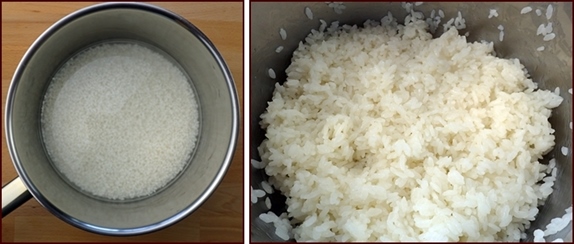
Photos: Rinsed sushi rice, soaked for 30 minutes, and then cooked.
After ten minutes, turn off the stove, and let the rice sit for fifteen minutes, keeping the lid on the pot. Important: Don’t let any steam escape by lifting the lid off the pot. Your patience will be rewarded with perfect sushi rice.
Add the rice vinegar, sugar, and salt solution.
Professional sushi chefs use wooden bowls and spoons when mixing rice vinegar with rice. I used a wooden spoon and did the mixing in the pot. The objective is to be gentle with the rice. Drizzle the rice vinegar/salt/sugar solution over the rice and mix it in with a folding motion with the spoon.
Dehydrating Sushi Rice
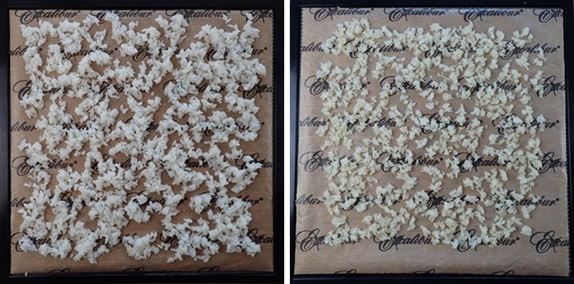
Photos: Dehydrating sushi rice before and after.
After you mix in the rice vinegar, and the rice has cooled a bit, place it on dehydrator trays covered with nonstick sheets. Two Excalibur dehydrator trays were used in this example. Since the rice sticks together, place one teaspoonful of rice at a time on the trays, leaving space between the little piles. Then, spread the little piles out a little more.
Dehydrate at 145°F (63°C) for 4–6 hours. When rice is almost dry, pull apart some of the rice that is sticking together and redistribute on the trays. Rice will be hard when dry.
Yields: 1¼ cups of uncooked rice (250 g) yields 4 cups of cooked rice. After dehydrating the rice, the volume is 2¼ cups dried rice (240 g).
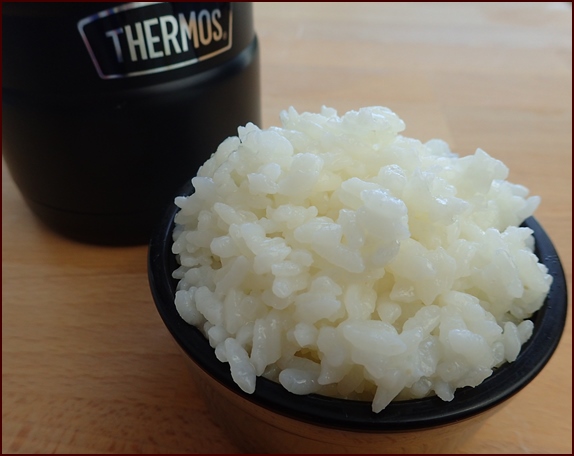
Photo: Sushi rice rehydrated with cold water in a thermos food jar after one hour.
For this example, ¾ cup dried sushi rice (80 g) was rehydrated with ½ cup cold water (112 ml). Rice was firm, not hard, with good texture. The sushi rice retained its sour, sweet, and salty flavors.
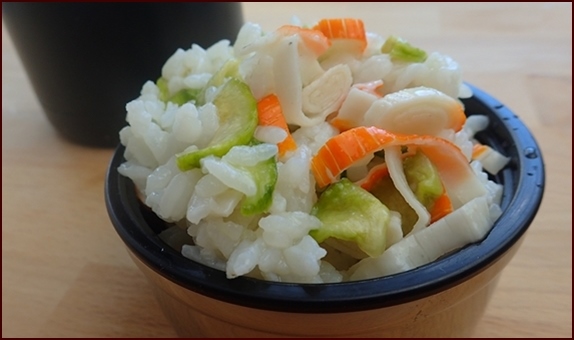
Explore the cold-soak salad recipe shown above:
Dehydrating Short-grain Rice
Dehydrated short-grain rice rehydrates well in cold water, making it an ideal choice for cold-soak salsa salads. For this recipe, use the same rice as was used to make sushi rice. Follow the instructions for cooking and dehydrating sushi rice above, but cook the rice in salted water and omit the rice vinegar.
Double Portion:
- 2½ cups short-grain rice (500 g)
- 3 cups water (710 ml)
- 2 tsp. salt
Yields: 2½ cups of uncooked rice (500 g) yields 8 cups of cooked rice. After dehydrating the rice, the volume is 4½ cups dried rice (470 g).
Dehydrated short-grain rice is delicious in cold-soak salsa salads as shown below.
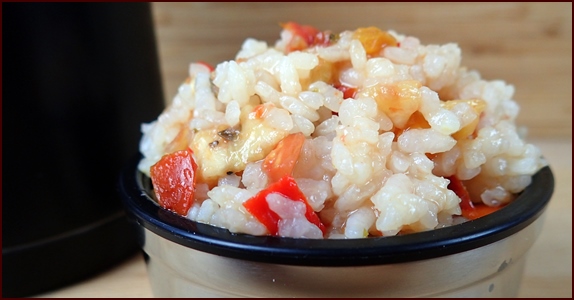
Explore the cold-soak rice salad recipe shown above:
Backpacking Meals with Dehydrated Rice
Explore More...
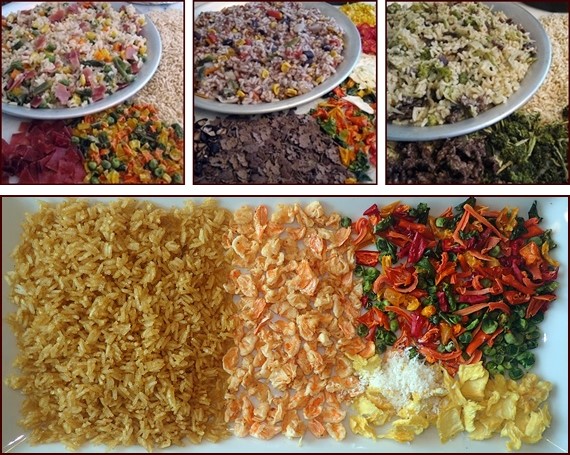
Unstuffed Peppers, Mexican Beef & Rice, Curry Chicken & Rice, Easy Cheesy Rice & Beans, Hawaiian Shrimp & Rice, and more.
Food Drying & Trail Cooking Gear Guide
Products to help you with your food drying projects and trail cooking adventures. I use the featured products regularly, or they are recommended by Backpacking Chef readers.
Share this page with friends on social media.
Free E-book & Newsletter
Free with Trail Bytes subscription.
Dehydrating Food from A–Z

